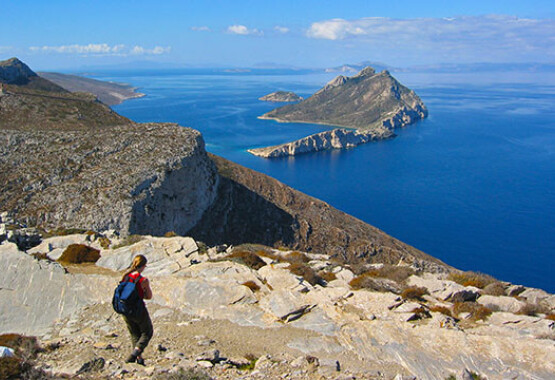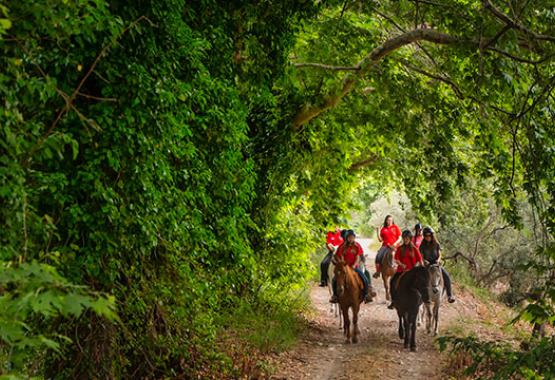
SKYROS
This rare bird of prey prefers the island of Skyros where it has built the world’s largest colony, with more than 1,050 pairs visiting the island to nest from April to October when they return to East Africa.
The archipelago of Skyros is also the place to see all the breeding seabirds of Greece, such as European shag, Cory's Shearwater) and Audouin’s Gull, while the island’s ecosystem is home or serves as a temporary residence for a wide variety, including Bonelli's Eagle, herons, ducks, nocturnal and diurnal birds of prey, waders, seagulls, terns, columbiformes, swallows, passeriformes, passerines, wagtails, leaf warblers, finches and buntings.
The imposing mass of Kochilas whose highest peak, Profitis Ilias, sits pretty at 792 meters, is Skyros’ highest mountain, and an ideal place for the hundreds of the islands’ different species to nest. Naturally, it is also a popular destination for birdwatchers.
Located in the southern part of the island and stretching along its coastline, Kochilas, and its habitat, is a hospitable transit place for migratory birds to rest and feed. Among the species found here are Bonelli's Eagle, finches, buntings, warblers and Falco Eleonorae.
Kalamitsa
The wetland of the Kalamitsa area is the island’s largest and the ideal stopover for migratory birds. Its large area, almost 70 hectares, its geographical location, as well as the hundreds of trees, shrubs and crops that extend around the perimeter, attract several aquatic birds, including western marsh harriers, little egrets, purple herons, shrikes, red-footed falcons, whinchats, wheatears and black-crowned night herons.
Aspous beach
Aspous is located 5 km south of the city of Skyros. It is a rocky beach with two bays stretching along the coastline, and serves as a tranquil place to observe the birds that frequent the area. At the two neighboring bays, Aspus and Achilli, discreet birdwatchers can observe European shags and Audouin’s Gulls that arrive there to find food, but also to rest on the rocks. Lonely Kingfishers and sandpipers are less common, as are the cormorants which prefer the small pier located at Achilli bay.
Ferekampos’ gully
Located near a dense pine forest, Ferekampos’ gully is one of the most important wetlands of the island. It is a meeting point, mainly in the spring and autumn, of migratory birds of all kinds, including hawks, gulls, terns, glossy ibises, ducks, western marsh harriers, as well as herons, which arrive there in the winter.
The dirt road on the south side is an ideal choice, as it offers a panoramic view of the ravine. The fields surrounding the wetland are well worth checking out as they are frequented by the common kestrels, larks, corvidae, buntings, finches and stonechats.
Palamari - Trachy
A must see destination for birdwatchers, Palamari-Trachy, is located in the northern part of the island, a stone's throw from Skyros airport. The estuary of the stream in Palamari and the plain in Trachy delimit an area of a few dozen hectares with alternating landscapes and soil morphology that attract diverse bird species, such as freshwater birds, those fond of flat areas, shrub and phrygana species, as well as birds of prey and seabirds.
Birds that nest here include stone curlews, bee-eaters, warblers and little ringed plovers. It is also an area to watch migratory birds, such as the sandpipers, waders and ruffs. Birds that stay throughout the winter include snipes, ducks and terns.
In addition, birdwatchers in the fields can also marvel at whinchats, hoopoes, swallows, montagu’s harriers, pallid harriers and red-footed falcons. The owls that are still visible in the light of day on Skyros can also spring a pleasant surprise.
Birdwatching on Skyros
Observing feathered creatures in the heart of the Aegean
Skyros is an island full of contrasts, special protection zones for birds and part of the NATURA 2000 network, as well as an ultimate attraction for bird lovers. Sparsely populated with large nature areas, uninhabited islets, a barren rocky landscape on its southern side and a variety of habitats, it is ideal for birdwatching as it boasts 205 recorded bird species from 48 different feathered families. Prospective birdwatchers can simply equip themselves with a pair of binoculars, an identification guide and a notebook and flock to the island's habitats to enjoy a unique nature-loving experience.The "King" of the island and the impressive ornithological variety
Among the most interesting birds you can encounter on Skyros is the Falco Eleonorae (Mavropetritis), a migratory hawk that comes to the Mediterranean to breed, showing a special preference for Greece which hosts 85% of its world population.This rare bird of prey prefers the island of Skyros where it has built the world’s largest colony, with more than 1,050 pairs visiting the island to nest from April to October when they return to East Africa.
The archipelago of Skyros is also the place to see all the breeding seabirds of Greece, such as European shag, Cory's Shearwater) and Audouin’s Gull, while the island’s ecosystem is home or serves as a temporary residence for a wide variety, including Bonelli's Eagle, herons, ducks, nocturnal and diurnal birds of prey, waders, seagulls, terns, columbiformes, swallows, passeriformes, passerines, wagtails, leaf warblers, finches and buntings.
The top spots in Skyros for an unforgettable birdwatching experience
Mount KochilasThe imposing mass of Kochilas whose highest peak, Profitis Ilias, sits pretty at 792 meters, is Skyros’ highest mountain, and an ideal place for the hundreds of the islands’ different species to nest. Naturally, it is also a popular destination for birdwatchers.
Located in the southern part of the island and stretching along its coastline, Kochilas, and its habitat, is a hospitable transit place for migratory birds to rest and feed. Among the species found here are Bonelli's Eagle, finches, buntings, warblers and Falco Eleonorae.
Kalamitsa
The wetland of the Kalamitsa area is the island’s largest and the ideal stopover for migratory birds. Its large area, almost 70 hectares, its geographical location, as well as the hundreds of trees, shrubs and crops that extend around the perimeter, attract several aquatic birds, including western marsh harriers, little egrets, purple herons, shrikes, red-footed falcons, whinchats, wheatears and black-crowned night herons.
Aspous beach
Aspous is located 5 km south of the city of Skyros. It is a rocky beach with two bays stretching along the coastline, and serves as a tranquil place to observe the birds that frequent the area. At the two neighboring bays, Aspus and Achilli, discreet birdwatchers can observe European shags and Audouin’s Gulls that arrive there to find food, but also to rest on the rocks. Lonely Kingfishers and sandpipers are less common, as are the cormorants which prefer the small pier located at Achilli bay.
Ferekampos’ gully
Located near a dense pine forest, Ferekampos’ gully is one of the most important wetlands of the island. It is a meeting point, mainly in the spring and autumn, of migratory birds of all kinds, including hawks, gulls, terns, glossy ibises, ducks, western marsh harriers, as well as herons, which arrive there in the winter.
The dirt road on the south side is an ideal choice, as it offers a panoramic view of the ravine. The fields surrounding the wetland are well worth checking out as they are frequented by the common kestrels, larks, corvidae, buntings, finches and stonechats.
Palamari - Trachy
A must see destination for birdwatchers, Palamari-Trachy, is located in the northern part of the island, a stone's throw from Skyros airport. The estuary of the stream in Palamari and the plain in Trachy delimit an area of a few dozen hectares with alternating landscapes and soil morphology that attract diverse bird species, such as freshwater birds, those fond of flat areas, shrub and phrygana species, as well as birds of prey and seabirds.
Birds that nest here include stone curlews, bee-eaters, warblers and little ringed plovers. It is also an area to watch migratory birds, such as the sandpipers, waders and ruffs. Birds that stay throughout the winter include snipes, ducks and terns.
In addition, birdwatchers in the fields can also marvel at whinchats, hoopoes, swallows, montagu’s harriers, pallid harriers and red-footed falcons. The owls that are still visible in the light of day on Skyros can also spring a pleasant surprise.




